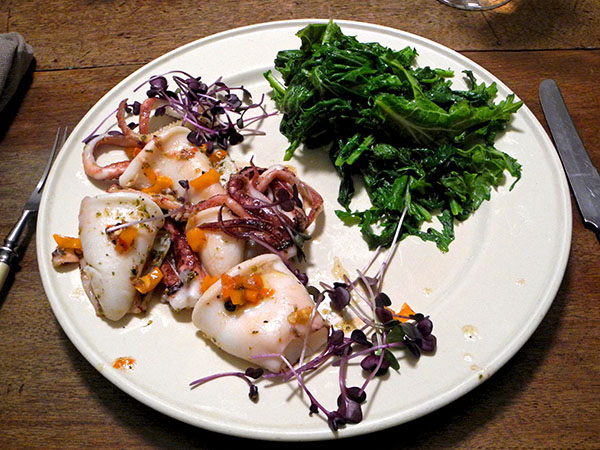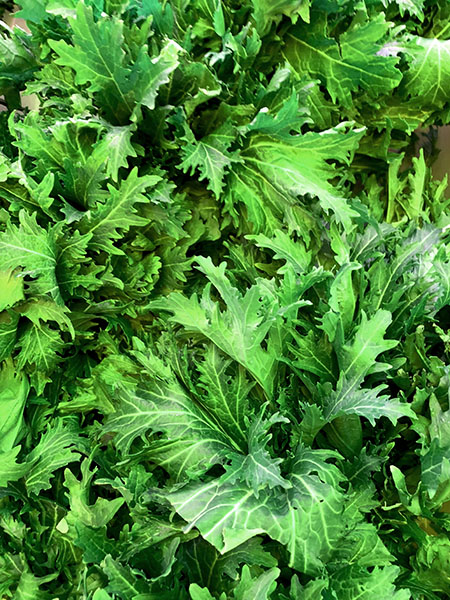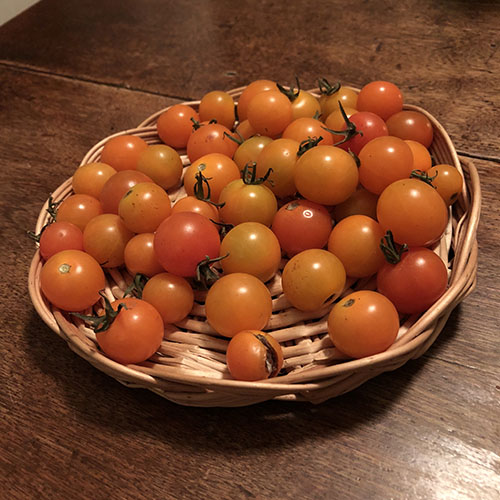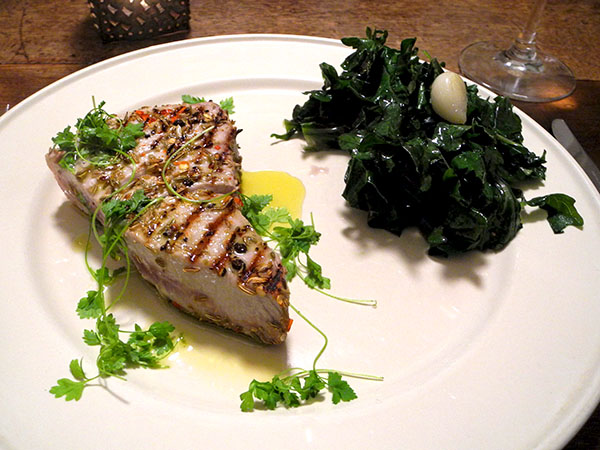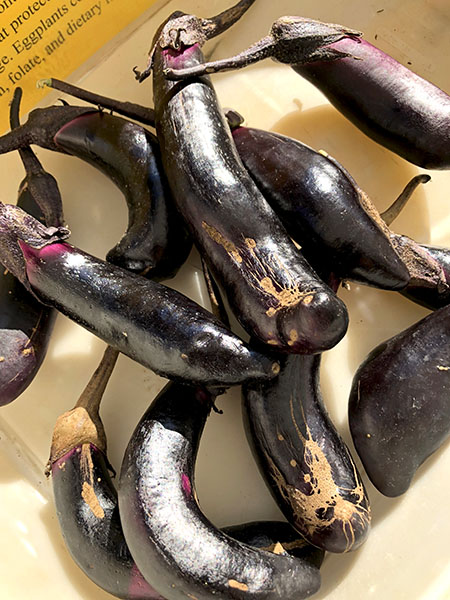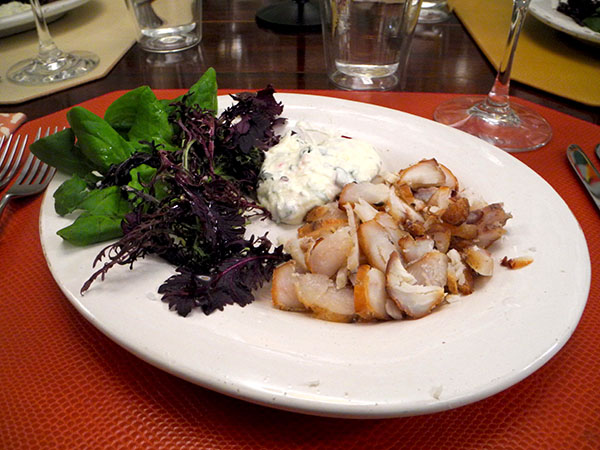
It was a very long and leisurely Thanksgiving meal, shared with good friends. The star on the table was not a roast turkey, but a braised three-and-a-half-pound Scottish hare, which was, as the fish in the first course, quite wild (one of our guests found a buckshot in his serving). There were no cranberries, although there was chutney, sweet potatoes, and greens, the ingredients in these all totally local. There were also many hours of American music, although none of it could be described as remotely hummable.
The vegetables, herbs, fruit, and creme, like everything other than the hare, came from local farmers and fishers in the area, and were purchased in the Union Square Greenmarket.
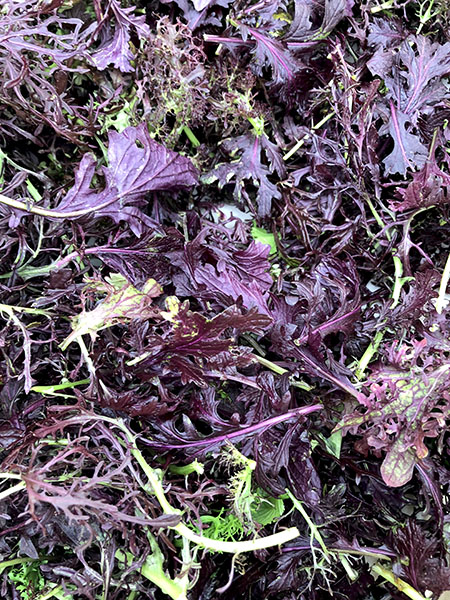




We toasted the day and our friendship with an American sparkling.
The first course was basically assembled, with a little help from the Greenmarket.
- pieces of smoked monkfish from Blue Moon Fish, served with some Ronnybrook Farm Dairy crème fraîche mixed with Whole Foods Market lemon zest and juice, fresh lovage from Two Guys from Woodbridge, grated horseradish root from from Gorzynski Ornery Farm, chopped small red scallion from Hawthorne Valley Farm, ground white pepper, and sea salt, arranged with some purple frizzy mustard greens from Lani’s Farm and salanova lettuce from Neversink Organic Farm, dressed with a very good Puglian olive oil, Alce Nero DOP ‘Terra di Bari Bitonto’ from Eataly, Maldon salt, and freshly-ground black pepper
- slices of a whole wheat sourdough Miche, or Pain de campagne, from Bread Alone
- the wine was a German (Rheingau) white, Robert Weil Riesling Estate Trocken 2016, the gift of a friend when we were in Berlin recently
The main course was Scottish wild mountain hare (the FDA does not allow us to buy any form of game bagged inside the US, but apparently trusts the Scots) purchased from brother Frank at Ottomanelli’s on Bleecker Street in the West Village, and supplied by Simpson Game, in the Scottish highlands.
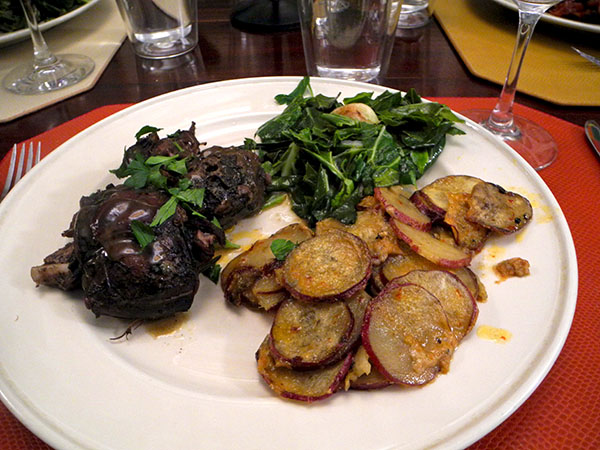
(the chutney didn’t make it to the plate in time for the picture)
- one three and a quarter pound Scottish mountain hare (“may contain shot”) from Ottomanelli’s Market, prepared, with some alterations, along the lines of an ancient recipe. ‘Lepre alla Cacciatora‘, that I had found in Anna Teresa Callen‘s ‘Food and Memories of Abruzzo, Italy’s Pastoral Land‘: the hare, once separated into pieces whose size would depend on the cook’s preference, placed inside a large bowl under running water for half an hour, drained and the hare returned to the bowl along with 1/4 cup of a good Italian white wine vinegar (Aceto Cesare Bianco) and enough cold cover to cover, left standing 20 minutes or so, the hare removed and half of the pieces placed inside a heavy enameled cast iron pan, half a cup more of the vinegar poured in, plus 4 sliced cloves of Rocambole garlic from Keith’s Farm, 2 sprigs of rosemary (each broken into 2 sections), several myrtle berries and leaves, one good-size piece of a crushed dark dry habanada pepper, 2 whole dried peperoncino Calabresi secchi from Buon Italia, sea salt and freshly-ground black pepper, followed by the remaining pieces of hare, fresh water added more than half way up the level of the meat, followed by a fourth of a cup of olive oil, the pot brought to a boil, the heat reduced to low and the hare allowed to cook at a simmer, without stirring, but shaken a few times, for about an hour, maybe more, but in any event only until it was tender, at which time a sauce ahould have been produced at the bottom of the pan [NOTE: I found that it had not been reduced enough, so I removed the hare pieces, boiled the liquid down until it was the proper consistency, and then, when it had slightly cooled, I added a few tablespoons of cold butter, stirring it in], finishing the now-sauced hare on the plates with some chopped parsley.
- quince chutney, made 2 days earlier, in order to fully develop its flavors, using this theKitchn.com recipe, using a red shallot from Norwich Meadows Farm, a Rocambole garlic clove from Keith’s Farm, quince from Troncillito Farms, dried sweet cherries (don’t know whether they were local) from Whole Foods, and fresh ginger from Lani’s Farm, apple cider vinegar from Race Farm
- two pounds of Japanese sweet potatoes from Lani’s Farm, sliced thinly, seasoned with salt and pepper, arranged in 4 layers, each separated in succession by a portion of 2 cups of heavy cream that had been mixed in a blender with one chipotle pepper and a small amount of adobo sauce, inside a 8″x12″ glazed ceramic casserole dish, baked inside a 350º oven for about one hour, or until the cream had been absorbed and the potatoes browned (this gratin recipe, one I’ve used many times, is from ‘Bobby Flay’s Bold American Food‘, it appears as ‘Sweet Potato Gratin with Smoked Chiles’)
- collard greens from Keith’s Farm, the stems torn off and the leaves sliced thickly, washed several times and drained, transferred to a smaller bowl very quickly, in order to retain as much of the water clinging to them as possible, wilted inside a heavy oval enameled cast iron pot in which 3 halved Rocambole garlic from Keith’s Farm had first been allowed to sweat in a bit of olive oil, the greens finished with a little sea salt, freshly-ground black pepper, and a drizzle of olive oil
- the wine was a California (Napa) red, Duckhorn Vineyards Napa Valley Cabernet Sauvignon 2010, the very generous gift, earlier in the year, of 2 New York friends
There was a cheese course, which included local cheeses, also from the Union Square Greenmarket, a choice of local apples, and more of the local bread, this time in the form of very thinly sliced toasts.
- the cheeses were all from Consider Bardwell Farm: ‘Manchester’ goat milk cheese, and 2 cow cheeses, ‘Pawlet Reconsided’, and ‘Bardem Blue’
- the apples were all from Samscott Orchards: ‘Newtown Pippin’, ‘Ashmead’s Kernel’,and ‘Stayman Winesap’
- the toasts were from the loaf of whole wheat sourdough we had enjoyed with the first course
- the wine was an Italian (Campania) white, Falanghina “Sannio” Terra di Briganti 2015, from Astor Wines
Our guests had brought with them from Brooklyn a really fantastic pear cheesecake, from Choice Market, on Lafayette Avenue, which we enjoyed later in the evening.
